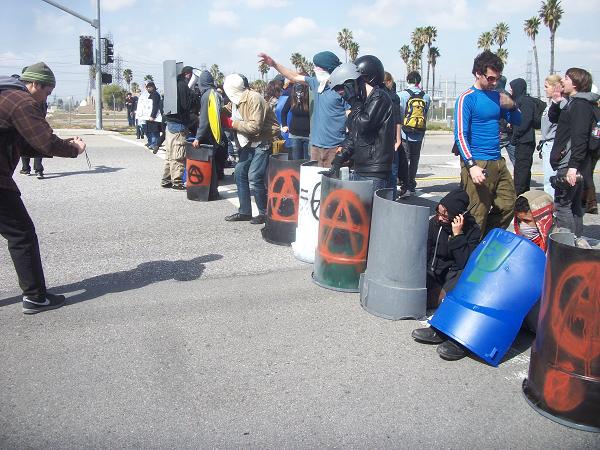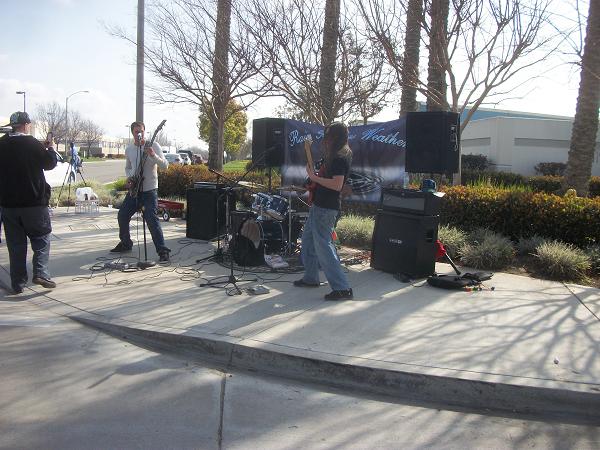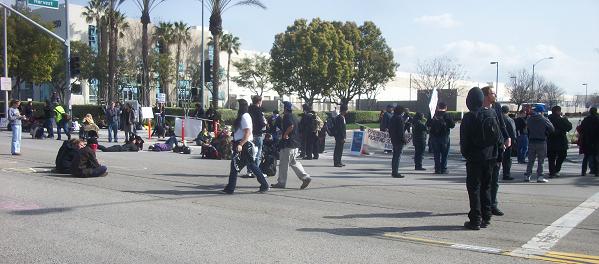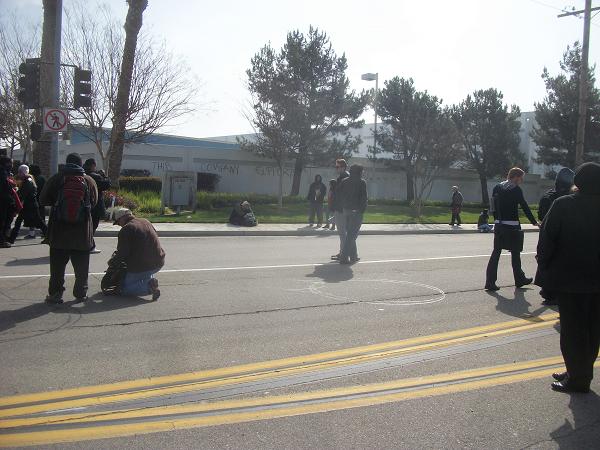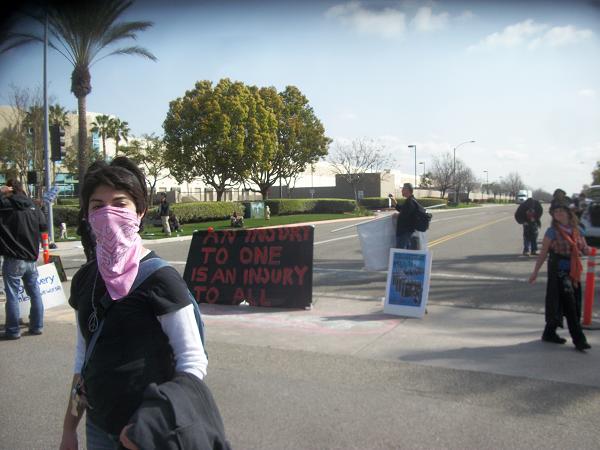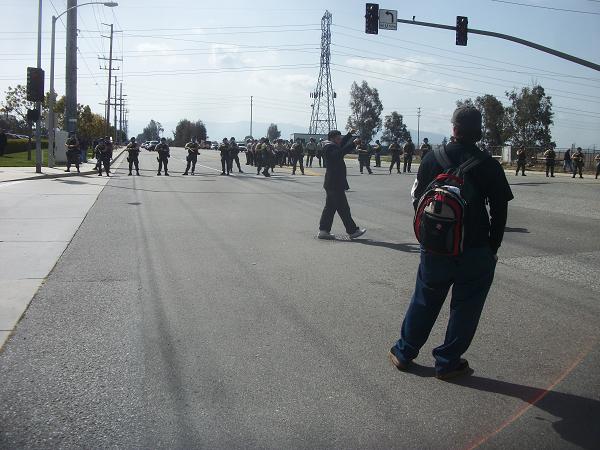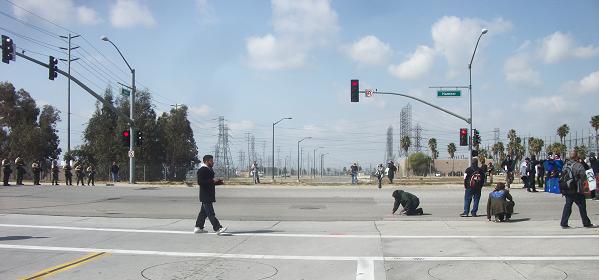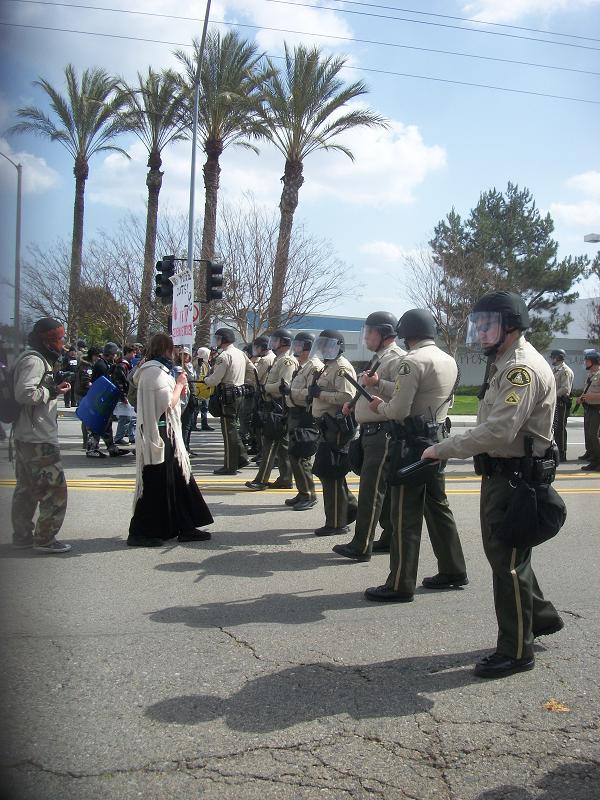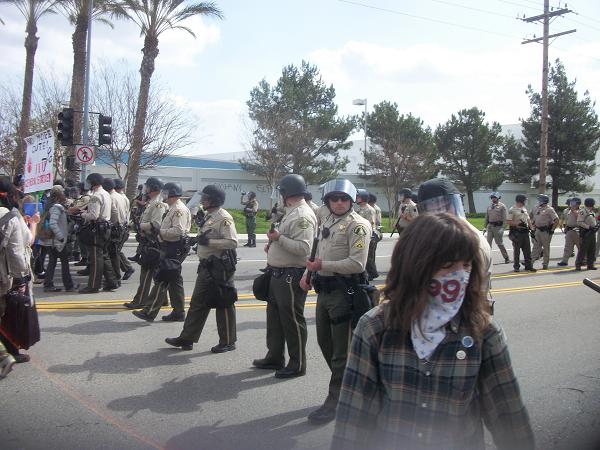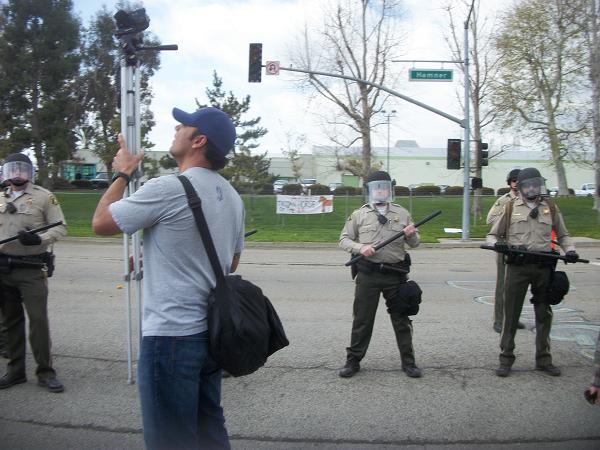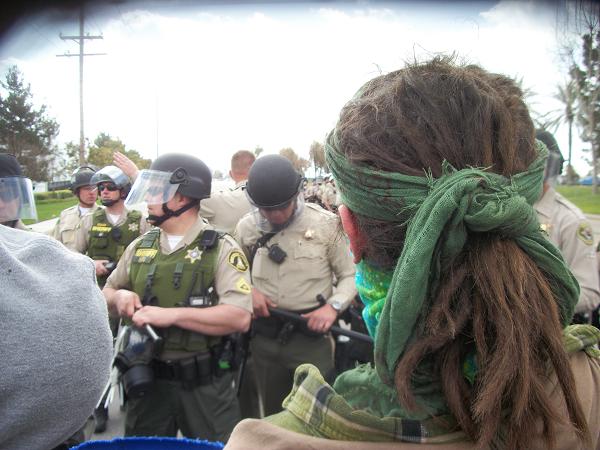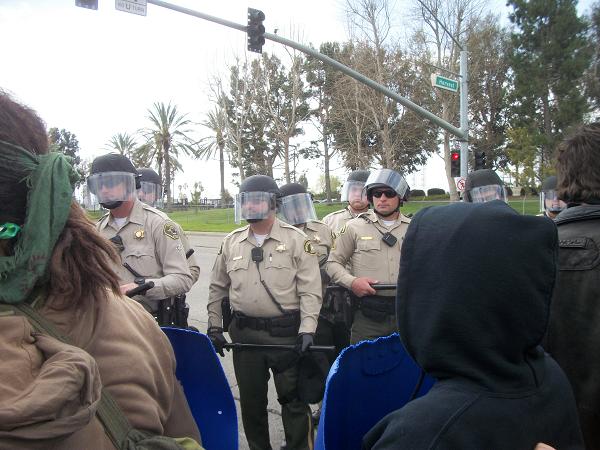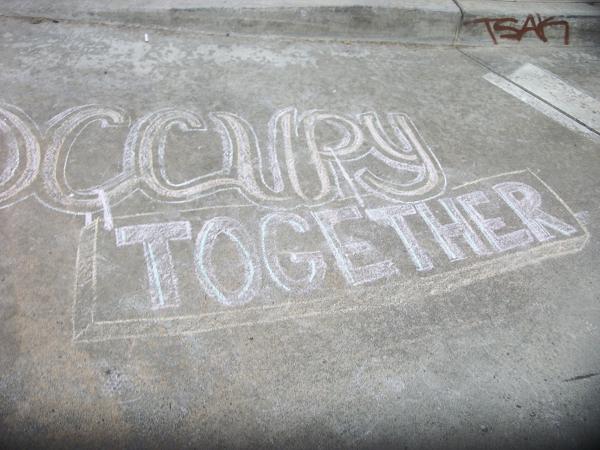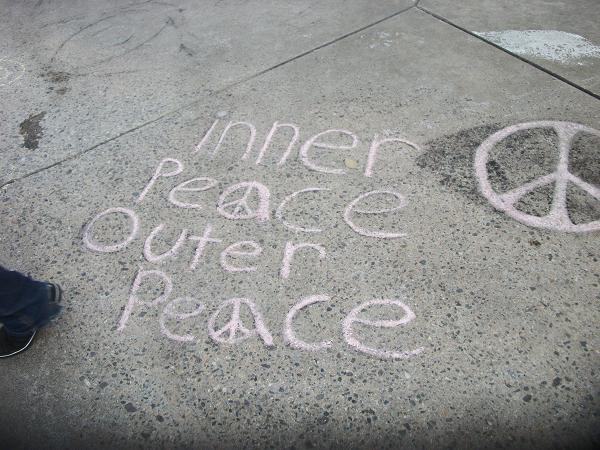http://la.indymedia.org/news/2012/03/251808.php
by Rockero
Friday, Mar. 02, 2012 at 5:03 PM
rockero420@yahoo.com
Wednesday, February 29, 2011
EASTVALE, California - Nearly 300 people arrived at six in the morning
in this desolate inland city with the intent to shut down the world's
largest distribution center for Walmart goods. Activists from Occupy
Riverside, Occupy LA, other Southern California occupys, community
activists, and student groups arrived at the Schneider warehouse only to
find that the management had closed the facility of its own accord.
Having tasted victory at dawn, the group soon set its sights much
higher.
Ever since Occupy Los Angeles called for a general
strike on May 1 to counteract the repression of the occupy movement,
stand for principles of democracy and liberty, and inspire the working
class to recognize its own power, Occupy Riverside has been organizing
to make the day, now just two months off, a success.
The buildup strategy unfolds in many ways, but one important part of it
is to have large actions every month. January saw the large mobilization
in defense of public education at UC Riverside, and the plan to target
the Inland Empire's sprawling logistics industry was hatched well before
then after occupy activists decided to do something about the labor and
human rights abuses rampant in the warehouses in our area.
Many Occupy Riverside activists have worked in the warehouses themselves
and know firsthand the plight of the workers, who are processed by
temporary agencies like products through a mill. Those who have not been
there themselves have family members who work there. And even those of
us whose connection to the industry is not as direct must still suffer
the impacts of depressed prevailing wages, weak labor protections, and
the environmental racism of contamination from the trucks and trains
that deliver merchandise from the ports to our warehouses before they
are shipped to the rest of the country--mostly by "independent
contractor" (that is, non-union) truckers.
After shutting down the ports on December 12, it natural for us to want
to do something here, at the next leg of the supply chain. We made
contact with labor advocates struggling to organize the warehouse
workers and learned that the most egregious abuses were occurring at
facilities moving goods for the corporation that is the bane of
justice-lovers worldwide: Walmart. After exploring with them how to best
keep the workers safe, we proceeded to coordinate with comrades from
Occupy LA and elsewhere, who endorsed the action and pledged to
participate.
At an early OLA general strike committee meeting, we heard of Occupy
Portland's call to shut down the corporations on February 29. "Leap into
action" was the tagline for the national day of nonviolent direct
action, which focused on the corporations comprising ALEC, the American
Legislative Exchange Council.
(ALEC is a consortium of corporations and state legislators that drafts
and passes pro-corporate, anti-worker legislation and subsequently
"exchanges" it by passing the same or similar laws in other states. The
anti-union law signed by Governor Walker of Wisconsin, which prompted
the pre-Occupy occupation of the capitol in Madison, was an ALEC
brainchild, as was the racist Arizona law SB 1070, which was dreamed up
by corporations operating private prisons and detention facilities.
Walmart, as the most anti-union force in the world, is a major player in
ALEC.)
Workers at the Schneider warehouse were scheduled for dismissal on
February 24 for simply speaking up and demanding their rights. The
timing and climate was perfect, and the call to action was made.
A court later enjoined Schneider from firing the workers, but that order
did nothing to change the desperate conditions of the workers or
correct the undemocratic practices of Walmart and ALEC.
So after a rough night of intensive know-your-rights and non-violence
training, followed by a campout (complete with camp fire) in the
backyard of an Occupy Riverside comrade, the swarm of resilient
occupiers arrived. We marched down Hamner, taking the street from the
get-go. Our goal was to shut down the warehouse during peak trucking
hours, from six until noon. The empty parking lot was a dead giveaway
that the warehouse had closed for the day, but we set up a picket line
regardless. Not only was there no resistance from the company, but there
was none from the police, either. There was not a uniformed officer in
sight.
Number of warehouses shut down: 1
Soon, however, we grew impatient. Our researchers had identified another
Schneider warehouse just around the corner from the primary target, as
well as another nearby Walmart distribution center. As we made moves to
create a presence at these secondary targets, our scouts informed us
that they were also abandoned, also shut down for the day.
Number of warehouses shut down: 3
We had enough people to secure the non-operation of the first Schneider
warehouse, so another group set out southward on Hamner Avenue to
blockade the entrance to an Ingraham-Micro warehouse, which moves goods
for IBM, Apple, and other high-tech companies who also happen to be ALEC
members, where observers spotted trucks entering and exiting and they
decided to blockade the entrance there.
Number of warehouses shut down: 4
Soon after the Micro warehouse shutdown, police seemed to be responding
by blocking off traffic at a great distance away--as far north as
Riverside Drive, and as far South as Cantú-Galleano Road. It was
difficult to tell because they were so far away. Regardless, truck
traffic was no longer entering the road, effectively shutting down
operations at six more warehouses.
Number of warehouses shut down: 10
It was at the Micro entrance that a small conflict arose about what to
do about a trucker who wished to exit the grounds. Many people blocked
his exit. He explained to them that his container was empty, that he
wasn't hauling for Walmart, and that he was an independent contractor
who, unlike the unionized UPS truck stuck inside, was not being paid.
This persuaded several people who argued that in addition, the action
was to prevent the warehouses from profiting from the exploitation of
its forklift drivers and order-pullers by preventing the delivery of
merchandise, not to prevent the truckers from profiting.
Those in favor of maintaining the blockade argued that the objective was
to shut down commerce entirely, not just the warehouses, and that if we
let one person go through, where would we draw the line? It took a
while, but eventually those in favor of letting him go won out.
By then it had become clear that police were amassing at the ends of
road and lining up. But they were still a ways off, so to pass the time,
a local alternative rock band came out and played a set.
Before they finished, a police line approached the intersection where
people were blocking the entrance to the Micro building and asked them
to leave. The people held the street and held their ground. After what
seemed like an eternity of facing from opposite sides of the
intersection, the cops started moving forward. Slowly, maintaining its
line, the crowd backed up. The sheriff's deputies barked at us to get
back, and futilely ordered us walk up the sidewalk back to the protest.
It took them quite a while to push us down the long and wide street. But
by about 11:30, we were already within a hundred yards of the main
group at the Schneider and in danger of being surrounded at close
quarters. It was then that many people began to enter the grounds of a
natural foods company across the street. Earlier, medics had secured
permission to use the grounds if anyone needed to be evacuated for
medical purposes. But the presence of people on either side of the open
gate prevented police from advancing because to do so would have left
them exposed on one side.
Eventually the owners herded the occupiers out politely but the move had
bought us some time. We were then pushed back to the street of our
original picket line and ordered onto it so we could "continue our
peaceful protest." When we refused to do so, we were ordered to disperse
and began exiting up the sidewalk, which police lined on one side to
keep us off the street.
But they did not line the whole street, so after the police line ended,
we retook the street. This time the police used a different tactic. We
continued to retreat peacefully from their line, moving slowly to ensure
everyone's safety. But they became aggressive and hostile. On one side
of the line, near the bushes lining the Schneider warehouse parking lot,
an officer charged the man in front of him with his truncheon. The
deputies on either side of the aggressor likewise rushed out just behind
him, in a sort of "V" formation. Some people were thrown into the
bushes and likely sustained injury, and some individuals appeared to
have been a bit trampled in the melee as well. Two of them were
arrested.
Two other charges were made after the same fashion: one towards the
middle of the line, and another just afterward, from the side. Officers
targetted individuals to jab with their batons, to strike at in the
legs, and to grab by the head. At least one pig fell while running and
knocked his face shield off.
These rushes caused panic and extremely unsafe conditions but protesters
remained as calm as possible and regroup. They condemned the police
violence and vowed to return.
As with any action, there are lessons to be learned, but for the most
part, the activists expressed satisfaction with the day. Surpassing by
tenfold the goal of shutting down the warehouse, successfully remaining
nonviolent and working together, holding ground, and never once asking
for permission to do any of it from anyone.
